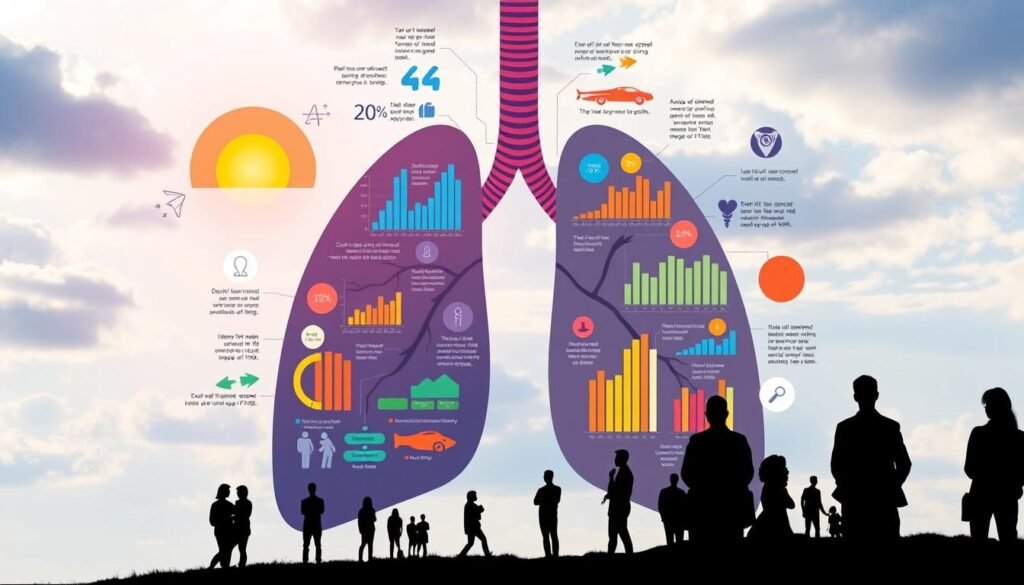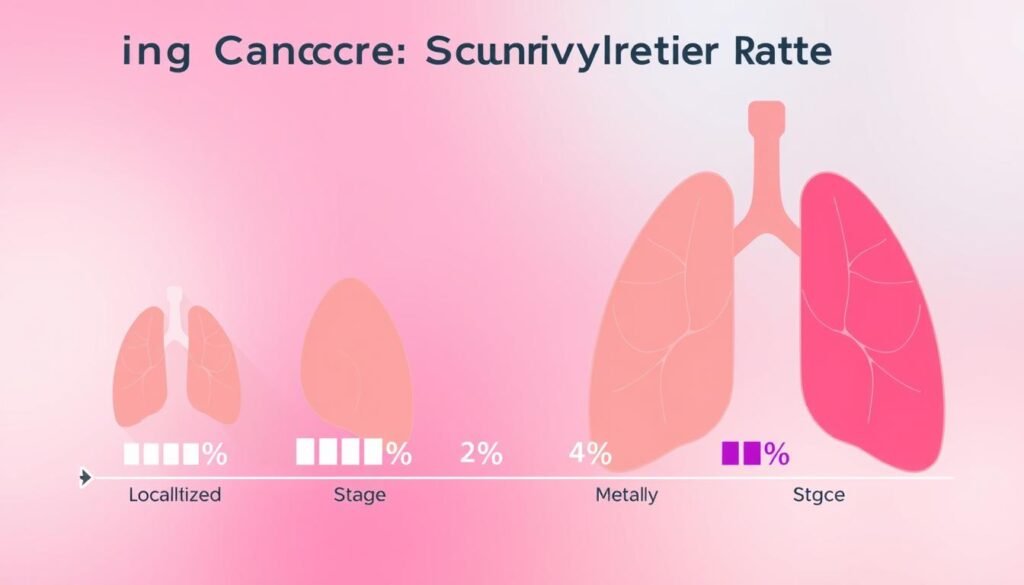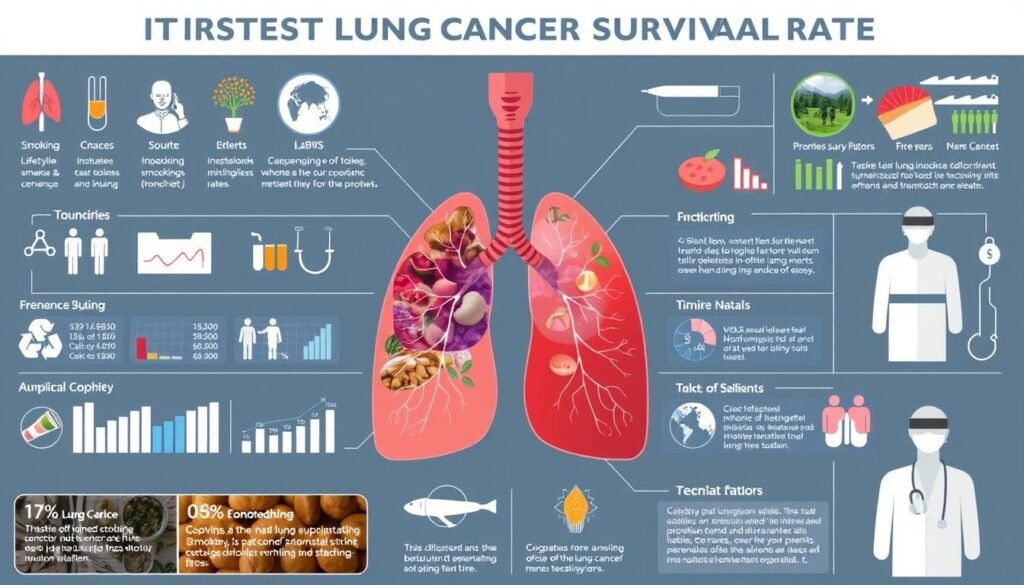Lung cancer takes more lives each year than other cancers in the U.S. Less than 20% of those diagnosed survive past five years. It’s vital to understand the overall lung cancer survival rate. Factors like cancer type, stage at diagnosis, age, and health affect it.
It’s important for patients and their families to learn about these factors. They help in making treatment choices and setting recovery expectations. To learn more about survival rates and how they vary between non-small cell lung cancer and small cell lung cancer, visit Lung Cancer Survival Rates. Knowing this can empower patients and boost their prognosis.
Key Takeaways
- Overall lung cancer survival rate varies significantly by stage at diagnosis.
- Survival rates for lung cancer can influence treatment decisions.
- Factors such as age and health impact individual prognosis.
- Each type of lung cancer has distinct survival statistics.
- Receiving a diagnosis early can improve overall survival rates.
Introduction to Lung Cancer Survival Rates
Lung cancer survival rates are key in understanding what happens after diagnosis. These rates show the percentage of people who live for typically five years post-diagnosis. Sadly, lung cancer’s lung cancer mortality rate is very high, second only to pancreatic cancer. Currently, only less than one in five people survive lung cancer for five years. This underlines the huge hurdles patients face.
There are two main kinds of lung cancer, which are non-small cell lung cancer (NSCLC) and small cell lung cancer (SCLC). NSCLC makes up about 90% of lung cancer cases. Its survival rates depend on how early or late it’s found. For early cases, 60% of patients may live five years. But this drops to 33% for regional spread and just 6% for cases that have spread far. SCLC has even worse figures, with 29%, 15%, and 3% survival rates for the same stages, respectively.
Lung cancer survival statistics give patients and families important information. They help in talking to doctors about treatment choices and what to expect. As shown, better screening and new studies are crucial for improving chances of survival and beating lung cancer.
What is the Overall Lung Cancer Survival Rate?
The overall lung cancer survival rate is very important. It shows how long patients live after they find out they have lung cancer. This information helps patients and their families decide on treatments.
It also raises awareness about the disease. And it highlights the need for quick action.
Definition of the Overall Lung Cancer Survival Rate
The overall lung cancer survival rate shows how many patients are still alive five years after diagnosis. It’s a key measure that tells us how well treatments work. It also shows how healthy the patient group is in general.
Right now, 26.6% of lung cancer patients in the U.S. live for five years after their diagnosis. This is a 22% improvement from 2015 to 2019. It shows progress in treating lung cancer and finding it early.
Understanding the Calculation of Survival Rates
Survival rates are found by following patients to see who survives. This uses data from different healthcare places for a full picture. It looks at age, stage of cancer when found, and treatments.
For early stage diagnosed patients, the five-year survival rate is 63%. But only 20.8% had surgery as their first treatment in the U.S. This shows how crucial it is to act fast.
Knowing these numbers helps improve how lung cancer is treated. This can make the survival rate better over time.

Lung Cancer Survival Statistics by Type
Lung cancer shows different survival rates based on its type. Knowing these numbers helps with awareness and catching it early. Non-Small Cell Lung Cancer (NSCLC) and Small Cell Lung Cancer (SCLC) are very different. They differ in how aggressive they are and the survival rates.
Let’s look into the survival stats for these two main types of lung cancer.
Non-Small Cell Lung Cancer (NSCLC) Statistics
NSCLC makes up around 90% of lung cancer cases. The 5-year relative survival rates for NSCLC change a lot depending on how far the cancer has spread:
| Stage | 5-Year Relative Survival Rate |
|---|---|
| Localized | Approximately 65% |
| Regional | About 37% |
| Distant | As low as 9% |
The survival rates show why catching cancer early matters. People with early-stage NSCLC generally do better than those with advanced cancer. For more info on lung cancer survival rates, you can visit this resource.
Small Cell Lung Cancer (SCLC) Statistics
SCLC is very aggressive, leading to lower survival rates than NSCLC. Here’s the 5-year relative survival rate for SCLC based on its stage:
| Stage | 5-Year Relative Survival Rate |
|---|---|
| Localized | 30% |
| Regional | 18% |
| Distant | 3% |
These numbers highlight the need for early detection. The big differences in survival rates between NSCLC and SCLC show the importance of awareness and quick action in fighting lung cancer.
Lung Cancer Survival Rate by Stage
The stage of lung cancer at diagnosis greatly affects patient survival outcomes. Knowing the survival rates by stage helps understand the prognosis. Here is a summary of survival rates for different lung cancer stages.
Survival Rates for Localized Lung Cancer
Localized lung cancer is cancer that is still in the lungs. The 5-year overall survival rate for stage I is about 76.9%. This is a good sign and shows why catching cancer early is crucial. Patients diagnosed at this stage have a survival rate of 82.3%, highlighting the benefit of early treatment.
Survival Rates for Regional Lung Cancer
Regional lung cancer has spread to nearby lymph nodes. The survival rate drops to about 56.1% over five years. Yet, there’s hope with available treatments. The rate specific to lung cancer is 59.7% at this stage, showing early action is important.
Survival Rates for Distant Lung Cancer
Advanced lung cancer has spread far, affecting other organs. Here, the 5-year survival rate falls to 21.4%. The disease-specific survival rate is 26.4%, making early detection vital. These numbers stress the necessity of catching lung cancer early for better survival chances.
| Stage | 5-Year Overall Survival Rate | 5-Year Lung Cancer-Specific Survival Rate |
|---|---|---|
| Stage I | 76.9% | 82.3% |
| Stage II | 56.1% | 59.7% |
| Stage III | 32.6% | 37.2% |
| Stage IV | 21.4% | 26.4% |

Factors Affecting Lung Cancer Survival Rate
Lung cancer survival rates change due to many factors. It’s crucial to understand these impacts for predicting how lung cancer will progress and to make informed treatment choices. We’re looking at major factors that significantly alter survival rates.
Impact of Age on Survival Rates
Age is key in affecting lung cancer survival rates. Younger patients tend to have better survival chances because they’re generally healthier. But, interestingly, people above 60 show good 30-month survival rates too. This shows age is important in figuring out lung cancer outcomes.
Influence of Overall Health and Fitness
The overall health of a patient greatly affects their survival chances. Those in good health with few other illnesses respond better to treatment. Being fit increases the success of surgeries to remove tumors, boosting survival rates. But, those with other health issues face tougher battles.
Genetic Factors and Their Role in Prognosis
Genetics play a big role in lung cancer outcomes. Genetic differences can change how a patient reacts to specific treatments. Testing for these genetic variations helps create tailored treatment plans. This has a big effect on improving survival chances.

| Factor | Impact on Survival |
|---|---|
| Age | Younger patients generally have better survival rates |
| Overall Health | Better health leads to improved treatment responses |
| Genetic Factors | Genetic mutations can affect treatment efficacy |
| Weight Loss | Significant weight loss decreases prognosis |
| Performance Status | Higher performance status correlates with better prognosis |
| Sex | Women often have slightly better survival rates than men |
Understanding Lung Cancer Prognosis
The outlook for lung cancer plays a key role in choosing treatments and predicting results. The stage when lung cancer is found affects this outlook a lot. Knowing what influences the prognosis helps patients decide on their treatment path.
Importance of Early Diagnosis
Finding lung cancer early is crucial for a better outcome. Early-stage cancers have much higher survival chances. For example, the five-year survival rate is about 61% for early-stage lung cancer. This drops to only 7% for late-stage diagnosis. Early detection of signs and symptoms can lead to quick action. This increases the chances of effective treatment.
How Treatment Options Impact Prognosis
The choice of treatment greatly affects the prognosis of lung cancer. There are many treatments, each suited to different cancer types and stages. Key treatments include:
- Surgery for removing tumors in certain lung cancer cases
- Chemotherapy, which is aggressive against cancer cells
- Radiation therapy, used alone or with surgery
- Targeted drug therapy for patients with specific genetic mutations
- Immunotherapy, boosting the immune system against cancer
- Palliative care, focusing on symptom relief and quality of life
Every treatment has side effects, like tiredness or nausea. Knowing these and how they might affect health is key to understanding prognosis. With advancing treatments, customized care is shaping future outcomes positively.
Current Lung Cancer Mortality Rate Trends
There have been promising updates in lung cancer mortality rates recently. They are due to better ways to stop smoking and improved screenings. Now, people diagnosed with lung cancer are living longer, showing progress in survival rates.
Recent Improvements in Lung Cancer Survival
The drop in lung cancer death rates is significant. In 2021, lung cancer caused 134,592 deaths, with men and women affected differently. The rate for men was higher than for women. However, both have seen big drops since the highest rates.
Over the last five years, there’s been a big decrease. Death rates fell 20% for men and 14% for women.
Impact of Clinical Trials on Treatment Outcomes
Clinical trials are crucial for better lung cancer treatments. They test new therapies that can improve survival rates. Knowing how these advances impact survival is key for choosing treatments. For a detailed look at survival rates, visit here.
Lung Cancer Survival Rate Comparisons
Understanding lung cancer’s survival rate shows deep insights into its danger. It is behind in survival rates compared to breast, prostate, and colorectal cancers. This fact highlights lung cancer’s deadly nature. Looking into its survival rates helps us understand patient outcomes better.
Comparing Survival Rates with Other Cancers
The survival rates of lung cancer, when compared to other cancers, show a big difference. This is true for both non-small cell lung cancer (NSCLC) and small cell lung cancer (SCLC). The numbers highlight the struggle lung cancer patients face.
| Cancer Type | Localized Stage Survival Rate | Regional Stage Survival Rate | Distant Stage Survival Rate | Overall 5-Year Survival Rate |
|---|---|---|---|---|
| Non-Small Cell Lung Cancer (NSCLC) | 65% | 37% | 9% | 28% |
| Small Cell Lung Cancer (SCLC) | 30% | 18% | 3% | 7% |
| Breast Cancer | 99% | 86% | 27% | 90% |
| Prostate Cancer | 100% | 100% | 29% | 98% |
| Colorectal Cancer | 90% | 71% | 14% | 65% |
Relative Survival Rate Explained
The relative survival rate helps us accurately see lung cancer’s effect. It compares lung cancer patients’ survival to expected survival without the disease. With a relative survival rate below 21% lately, we see a big need for better treatments and awareness.
Future Perspectives on Lung Cancer Survival
The future looks brighter for those fighting lung cancer. New treatments are giving patients hope. Scientists are exploring treatments like targeted therapy and immunotherapy. These approaches aim to make a big difference in lung cancer outcomes. Teams of experts are also combining therapies to boost survival chances.
Emerging Treatments and Their Potential Impact
Recent advances in research have unveiled the complexities of lung cancer. This knowledge is paving the way for personalized treatments. Here are the key strategies making waves:
- Targeted therapies: These treatments zero in on specific genetic changes. They show great promise for patients with a certain type of lung cancer.
- Immunotherapy: This approach empowers the immune system to fight cancer. It’s helping to improve how long people live with the disease.
- Liquid biopsies: Techniques like ctDNA analysis spot cancer early and track treatment success. They’re changing the game in lung cancer care.
Clinical trials are essential in validating these new treatments. They’re revealing a steady rise in lung cancer survival rates. This fuels hope for even more progress. The shift towards treatments tailored to each patient is setting the stage for better outcomes.
Conclusion
The lung cancer survival rate is complicated. It is influenced by the cancer type, stage at diagnosis, patient age, and health. The statistics might look bad at first. However, research and new treatments offer hope to patients and their families. Early detection is very important for improving the outlook for lung cancer.
Early diagnosis of lung cancer can greatly improve survival rates. For example, the five-year survival can be as high as 73% for stage IA cancer. But it drops to just 13% for stage IV cancer. This shows how important it is to have early access to healthcare. Doing so can help many patients have better outcomes.
Being informed and proactive helps patients work better with their doctors. For more information on how life expectancy is affected by lung cancer, check out this resource. Knowing these details helps individuals manage their lung cancer journey more effectively. It brings hope for better survival rates in the future.